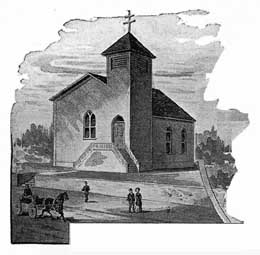On December 31, 1984, in the early morning hours, Everett’s oldest church building, the Lowell Community Church (5216 S. 2nd Avenue), is destroyed by fire. The structure dates back to 1892, its land and construction materials having been donated by Lowell’s founder, Eugene D. Smith (1837-1909). The old church is considered a total loss, but the congregation will rebuild on the same site.
Lowell’s Origins
In September 1863, Eugene D. Smith and Otis Wilson set up a logging camp on the Snohomish River at a site that eventually would become the town of Lowell. Smith left in 1865 to try his luck in the Coeur d’Alene Gold Rush, but came back to the Snohomish River broke and resumed logging. The Smith camp at Lowell was situated on a hill, about a mile and a half from the river. Here Smith built a timber-planked railroad to transport the huge felled trees out of the woods. A 2,000-foot chute allowed the logs to rapidly drop to the river below, where they were transported to regional mills. An earlier settler, Reuben Lowe, had operated a bordello here. In buying out Lowe, Smith decided to name the proposed town after Lowe’s hometown of Lowell, Massachusetts.
Smith platted the town in 1873 and the community’s population continued to grow. The beginnings of the city of Everett in the fall of 1891 changed Lowell’s future, since part of the development plans included a paper mill on the Lowell waterfront. Lowell soon became a company town, focused around the mill. Homes were built and Lowell’s population quickly grew, although the town was never incorporated. (It became a part of Everett in 1962.)
In 1891, E. D. Smith donated land and materials for a community church. Construction began that year and the structure was completed in 1892. Over the years, it became a source of pride for Lowell, and many residents attended. An addition to the structure subsequently was built, and the exterior was repainted and the interior refurbished. In the mid-1980s -- shortly before the fire -- the church was re-sided and the interior redecorated, the work done by volunteers.
New Year’s Eve 1984
The Everett Fire Department received the alarm call at 4:37 a.m. on December 31, 1984. When firefighters arrived at the scene, the church was completely ablaze, with flames roaring out through the building’s large stained-glass windows and consuming the second floor. They began fighting the blaze from outside, then went inside to inspect for several minutes and withdrew to change fire lines. They watched as the church roof collapsed onto the place where they had been standing only a few minutes before.
Inspection the following day determined the fire to have been accidental. It appeared to have started in the sanctuary near the altar and was likely due to faulty wiring. Volunteer work and contributions helped to rebuild the church. At the time of the fire, the congregation was affiliated with the United Church of Christ Congregational and is, in 2012, the River of Life Community Church.

